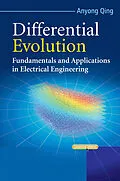Differential evolution is a very simple but very powerful
stochastic optimizer. Since its inception, it has proved very
efficient and robust in function optimization and has been applied
to solve problems in many scientific and engineering fields. In
Differential Evolution , Dr. Qing begins with an overview of
optimization, followed by a state-of-the-art review of differential
evolution, including its fundamentals and up-to-date advances. He
goes on to explore the relationship between differential evolution
strategies, intrinsic control parameters, non-intrinsic control
parameters, and problem features through a parametric study.
Findings and recommendations on the selection of strategies and
intrinsic control parameter values are presented. Lastly, after an
introductory review of reported applications in electrical and
electronic engineering fields, different research groups
demonstrate how the methods can be applied to such areas as:
multicast routing, multisite mapping in grid environments, antenna
arrays, analog electric circuit sizing, electricity markets,
stochastic tracking in video sequences, and color quantization.
* Contains a systematic and comprehensive overview of
differential evolution
* Reviews the latest differential evolution research
* Describes a comprehensive parametric study conducted over a
large test bed
* Shows how methods can be practically applied to
* mobile communications
* grid computing
* circuits
* image processing
* power engineering
* Sample applications demonstrated by research groups in the
United Kingdom, Australia, Italy, Turkey, China, and Eastern
Europe
* Provides access to companion website with code examples for
download
Differential Evolution is ideal for application
engineers, who can use the methods described to solve specific
engineering problems. It is also a valuable reference for
post-graduates and researchers working in evolutionary computation,
design optimization and artificial intelligence. Researchers in the
optimization field or engineers and managers involved in operations
research will also find the book a helpful introduction to the
topic.
Autorentext
Anyong Qing is a Research Scientist with Temasek Laboratories at the National University of Singapore. He has been involved in various areas of research in electromagnetics and evolutionary computation, producing pioneering work in solving electromagnetic problems using evolutionary algorithms. Qing has authored 4 book chapters, 49 peer reviewed journal papers, and 37 conference presentations, and altogether has been cited by other researchers over 150 times. He was invited to contribute a review on electromagnetic inverse problems for the Wiley Encyclopedia of RF and Microwave Engineering. He is also an invited speaker for EuMW, IST, PIERS, etc. Qing received a Guest Professorship at
Zusammenfassung
Differential evolution is a very simple but very powerful stochastic optimizer. Since its inception, it has proved very efficient and robust in function optimization and has been applied to solve problems in many scientific and engineering fields. In Differential Evolution , Dr. Qing begins with an overview of optimization, followed by a state-of-the-art review of differential evolution, including its fundamentals and up-to-date advances. He goes on to explore the relationship between differential evolution strategies, intrinsic control parameters, non-intrinsic control parameters, and problem features through a parametric study. Findings and recommendations on the selection of strategies and intrinsic control parameter values are presented. Lastly, after an introductory review of reported applications in electrical and electronic engineering fields, different research groups demonstrate how the methods can be applied to such areas as: multicast routing, multisite mapping in grid environments, antenna arrays, analog electric circuit sizing, electricity markets, stochastic tracking in video sequences, and color quantization.
- Contains a systematic and comprehensive overview of differential evolution
- Reviews the latest differential evolution research
- Describes a comprehensive parametric study conducted over a large test bed
- Shows how methods can be practically applied to
- mobile communications
- grid computing
- circuits
- image processing
- power engineering
- Sample applications demonstrated by research groups in the United Kingdom, Australia, Italy, Turkey, China, and Eastern Europe
- Provides access to companion website with code examples for download
Differential Evolution is ideal for application engineers, who can use the methods described to solve specific engineering problems. It is also a valuable reference for post-graduates and researchers working in evolutionary computation, design optimization and artificial intelligence. Researchers in the optimization field or engineers and managers involved in operations research will also find the book a helpful introduction to the topic.
Inhalt
Preface.
List of Figures.
List of Tables.
1 An Introduction to Optimization.
1.1 A General Optimization Problem.
1.2 Deterministic Optimization Algorithms.
1.3 Stochastic Optimization Algorithms.
1.4 Evolutionary Algorithms.
References.
2 Fundamentals of Differential Evolution.
2.1 Differential Evolution at a Glimpse.
2.2 Classic Differential Evolution.
2.3 Intrinsic Control Parameters of Differential Evolution.
2.4 Differential Evolution as an Evolutionary Algorithm.
References.
3 Advances in Differential Evolution.
3.1 Handling Mixed Optimization Parameters.
3.2 Advanced Differential Evolution Strategies.
3.3 Multi-objective Differential Evolution.
3.4 Parametric Study on Differential Evolution.
3.5 Adaptation of Intrinsic Control Parameters of Differential Evolution.
References.
4 Configuring a Parametric Study on Differential Evolution.
4.1 Motivations.
4.2 Objectives.
4.3 Scopes.
4.4 Implementation Terminologies.
4.5 Performance Indicators.
4.6 Test Bed.
4.7 Similar Works.
4.8 A Comparative Study.
5 Benchmarking a Single-Objective Optimization Test Bed for Parametric Study on Differential Evolution.
5.1 Motivation.
5.2 A Survey on Test Problems.
5.3 Generating New Test Problems.
5.4 Tentative Benchmark Test Bed.
5.5 An Overview of Numerical Simulation.
References.
6 Differential Evolution Strategies.
6.1 Sphere Function.
6.2 Step Function 2.
6.3 Hyper-ellipsoid Function.
6.4 Qing Function.
6.5 Schwefel Function 2.22.
6.6 Schwefel Function 2.26.
6.7 Schwefel Function 1.2.
6.8 Rastrigin Function.
6.9 Ackley Function.
7 Optimal Intrinsic Control Parameters.
7.1 Sphere Function.
7.2 Step Function 2.
7.3 Hyper-ellipsoid Function.
7.4 Qing Function.
7.5 Schwefel Function 2.22.
7.6 Sc…
